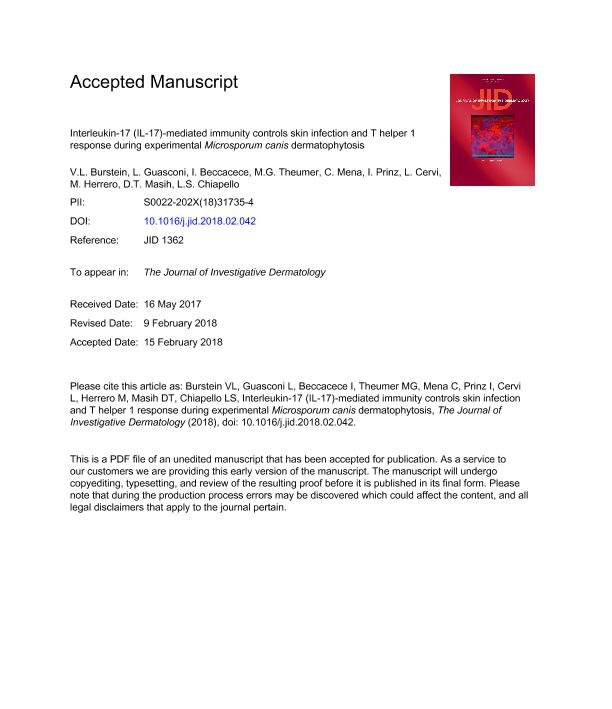Artículo
IL-17–Mediated Immunity Controls Skin Infection and T Helper 1 Response during Experimental Microsporum canis Dermatophytosis
Burstein, Verónica Liliana ; Guasconi, Lorena
; Guasconi, Lorena ; Beccacece, Ignacio
; Beccacece, Ignacio ; Theumer, Martín Gustavo
; Theumer, Martín Gustavo ; Mena, Cristian Javier; Prinz, Immo; Cervi, Laura Alejandra
; Mena, Cristian Javier; Prinz, Immo; Cervi, Laura Alejandra ; Herrero, Mónica; Masih, Diana Teresa
; Herrero, Mónica; Masih, Diana Teresa ; Chiapello, Laura Silvina
; Chiapello, Laura Silvina
 ; Guasconi, Lorena
; Guasconi, Lorena ; Beccacece, Ignacio
; Beccacece, Ignacio ; Theumer, Martín Gustavo
; Theumer, Martín Gustavo ; Mena, Cristian Javier; Prinz, Immo; Cervi, Laura Alejandra
; Mena, Cristian Javier; Prinz, Immo; Cervi, Laura Alejandra ; Herrero, Mónica; Masih, Diana Teresa
; Herrero, Mónica; Masih, Diana Teresa ; Chiapello, Laura Silvina
; Chiapello, Laura Silvina
Fecha de publicación:
08/2018
Editorial:
Elsevier
Revista:
Journal Of Investigative Dermatology
ISSN:
0022-202X
Idioma:
Inglés
Tipo de recurso:
Artículo publicado
Clasificación temática:
Resumen
Despite worldwide prevalence of superficial mycoses, the immune response in dermatophytosis has scarcely been investigated. In this study, we developed a model of superficial skin infection in C57BL/6 mice with Microsporum canis, a highly prevalent human pathogen. This model mimics mild inflammatory human dermatophytosis, characterized by neutrophil recruitment and fungal invasion limited to the epidermis and exhibits the establishment of a specific T helper type 17 immune response during infection. By using IL-17RA- or IL-17A/F-deficient mice we showed that, in the absence of a functional IL-17 pathway, M. canis extensively colonizes the epidermis and promotes an exaggerated skin inflammation and a shift to an IFN-γ-mediated (T helper type 1) response. IL-17 signaling was not involved in neutrophil influx to skin or fungal invasion to deeper tissues. Finally, this study shows that skin langerin-expressing cells contribute to the antifungal T helper type 17 response in vivo. In conclusion, these data directly show a dual function of IL-17 cytokines in dermatophytosis by controlling superficial infection and down-modulating a T helper type 1 antifungal response.
Palabras clave:
DERMATOPHYTES
,
IL17
,
LANGERHANS CELL
Archivos asociados
Licencia
Identificadores
Colecciones
Articulos(CIBICI)
Articulos de CENTRO DE INV.EN BIOQUI.CLINICA E INMUNOLOGIA
Articulos de CENTRO DE INV.EN BIOQUI.CLINICA E INMUNOLOGIA
Citación
Burstein, Verónica Liliana; Guasconi, Lorena; Beccacece, Ignacio; Theumer, Martín Gustavo; Mena, Cristian Javier; et al.; IL-17–Mediated Immunity Controls Skin Infection and T Helper 1 Response during Experimental Microsporum canis Dermatophytosis; Elsevier; Journal Of Investigative Dermatology; 138; 8; 8-2018; 1744-1753
Compartir
Altmétricas



